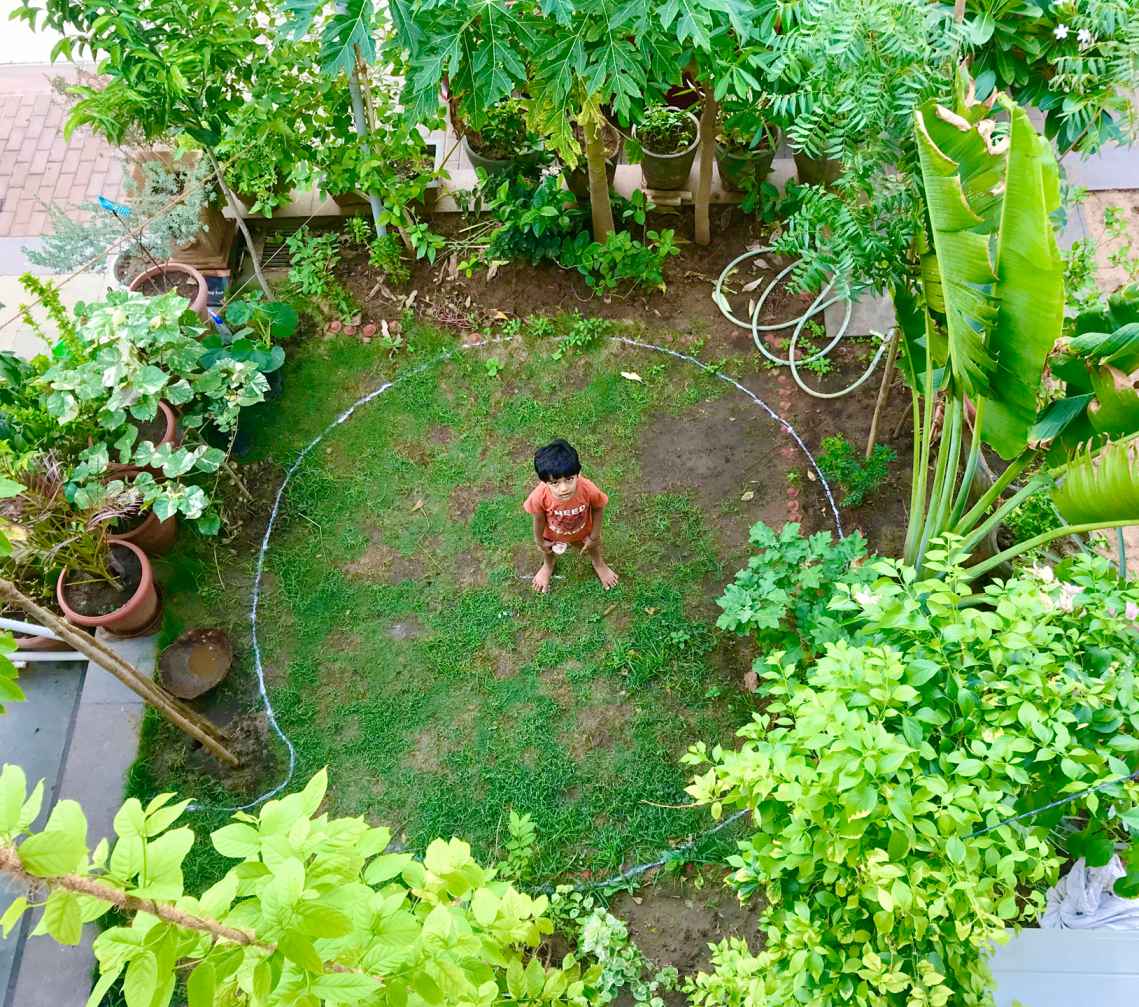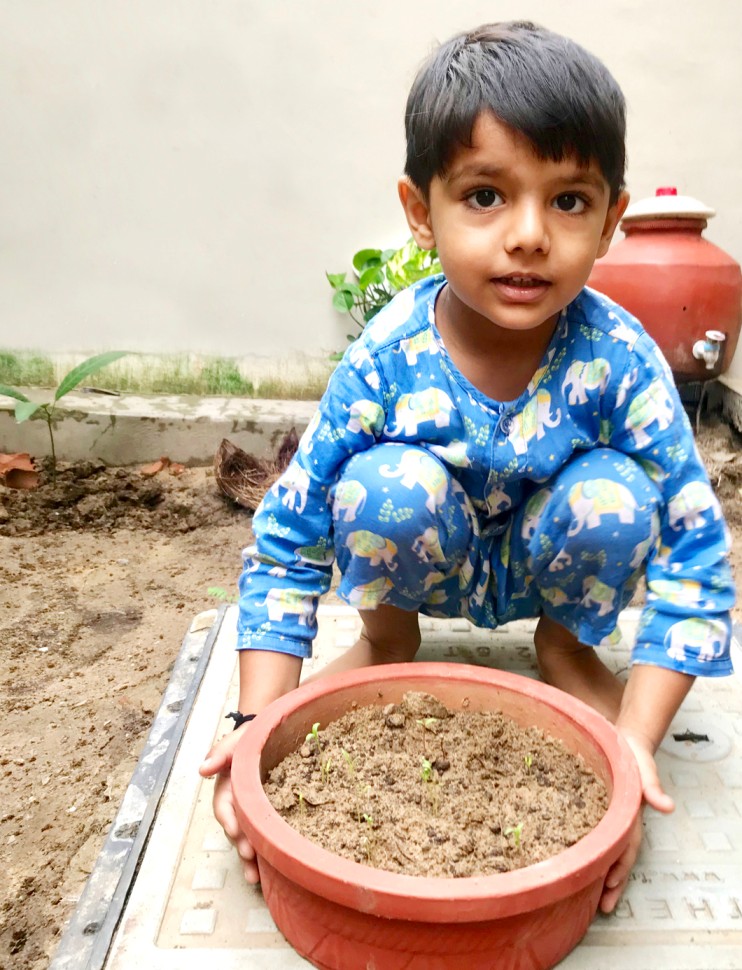My 3.5-YO and I Started Growing Our Own Food in 2020. Here’s What We Learned
Ruchita Jagzap is an architect who shuffles between Mumbai and Ahmedabad. She is also an urban designer by profession and the mother to a 4-year-old and shares the joys of gardening during the lockdown and the experience of planting over 101 saplings in her society.

I was always a plant lover but with several priorities and endless responsibilities that come along with being a practising architect, there weren’t many opportunities or enough time that would enable me to do enough justice to even call gardening a hobby!
But the pandemic turned a lot of things around. With work-from-home came so many opportunities; truly, as if life was waiting for this moment. Most important amongst them, was the chance to spend some quality time with my 4-year-old son. With small baby steps, together we continued our gardening activities which got full attention in due course and my son was engaged with me as a full-time assistant. What better can a parent wish as a learning experience filled with love, laughter and realisations?

So here are a few facts that made us our better selves in these months.
Soil Space
Space and size cannot be a constraint but the quality of sunlight and the direction of your plants/pots do matter.
During the lockdown, we got closer to our tiny little front-yard which provides approximately 138 sq ft of soil surface for plantation. Out of this, 77 sq ft is a lawn and hard surface together.
I deliberately reduced the lawn portion to enable more space for other plant species to enhance the diversity it brought to us. Hence in the remaining 61 sq ft lies our wilderness, tiny farmlets, edible landscapes, co-sharing experiences and a whole lot of joy. Our garden gave us some papayas which we could share with our neighbourhood friends, surplus tomatoes includes one of the harvests with 73 in numbers at a single go, handful of capsicums, chillies, brinjals, guavas, bottle gourds, curry leaves, mint leaves, ajwain leaves, drumstick leaves, beetroots, carrots, spinach, red spinach, methi, and endless blooms and fragrances.
For a Mumbaikar, 61 sq ft is a huge green space. So yes, a tiny space of soil can enhance your life.

Food for thought
Today, we realise that everyone should have knowledge about cooking; likewise, I would say that everyone, irrespective of their age should know how to grow their own food.
Growing an edible landscape is key to a lot of questions and healing for many illnesses. Apart from its endless benefits such as learning to be patient, valuing every bite of your meal, being conscious towards food wastage, developing a sense of gratitude towards the farmers and the traditional wisdom which we often ignore or simply value them very little. When you grow your own salad, you make sure it is consumed fresh and finished well.
The many challenges that come across while you plant a seedling and watch the failure or the miraculous harvests, you only learn to keep up with the unpredictability and enjoy the process despite some disappointments. You also start empathising with the farmers even more.

This empathy is important to come at an early stage in life as it teaches you to not be selective with particular shapes and sizes or specific colours or even the tastes of your harvest.
Today, if a 4-year-old understands to eat a papaya that could be less sweet than expected, a cucumber which is slightly distorted but delicious, a tomato that looks funny yet the same as others when it comes to taste, he knows it is perfect the way it is.
We then allow ourselves to evolve with our acceptance of diversity in all aspects of life.

Diversity as a lifestyle catalyst
We have a total of 113 plants in all sizes, habits, colours, variations and fragrances, in our front yard, inside our living spaces and on our terrace. The diverse flora happened only as a gradual and conscious process. When I learnt how a particular bird or an animal is attracted to a specific tree, I tried to explore more and brought some variety in the green space. This ensured more eco-guests (as I call them) visiting us and very often.
So we have varieties of finches, red-vented bulbuls, Mynas, common tailorbirds, purple sunbirds, Indian blue robins to name a few; and chameleons, ladybugs, honey bees, butterflies, of course, the monkeys and a few others that make guest appearances.

We saw the cocoon and how the caterpillars mutate into beautiful flying butterflies. Such miracles from nature are very inspiring. So few plants are dedicated to these butterfly cycles. Like a lemon plant is purely for the cocoons on it, we don’t expect lemons from it, there is another lemon we planted to receive a harvest.
This space became our learning platform.
We saw how each plant nurtured a specific bird or an animal and how diversity has brought so much love and charm to the space. I would only say that all the sanity that I have throughout this period and still going on, I owe to this newly developed love affair with the growing wilderness in my front yard and the learning experience of co-existence.
Zeroing the waste
Our green waste goes to the compost earthen pots (matkas) and we love feeding our plants with the same. Watching the whole cycle has given us much pleasure. All our green wastes like the peels, leaves goes into making a compost and that segregation is another important factor. We are still developing this process further to encourage as many in the neighbourhood.
Happiness attached
So here come the mental benefits as a perk of the process. Listening to the chirping birds, watering your plants, mulching, playing with the soil and harvesting has really given us more than food. It has kept us away from the negative thoughts, it has drained our energies in something productive, it has given us happiness amidst all the stress and tantrums (respectively to me and my child).
We look forward to it, we enjoy the tiny habitats or ecosystems that we have participated in, and we learn to change with the changing season and along with our co-exiting companions who do it very wisely. So now we want to share this happiness, and so whenever there is somebody’s birthday or celebration, we gift them a sapling and in return we get to hear some happy stories. Another fact to share, children love planting, especially when you tell them that this one’s for you!

I am also one of the active members in the green committee of our society. With the availability of our physical presence with work-from-home, we as a team decided to add more greens to the private and common areas by encouraging members and taking guidance from the professional gardener.
Till June 2020 we had successfully planted around 101 saplings in common areas and encouraged 80 houses to include a sapling in their private spaces, again with a diverse approach in mind.
We led a silent plantation drive keeping all the safety and precautions, ensuring no one gets infected. Today, the society’s green WhatsApp group is flooded with photos of increased bird species and shared tips for more organic gardening along with all praises to children who are developing this as a passion.

So I end my experience sharing on a note to develop furthermore. I intend to research co-existence in urban areas, planting for mental health and waste management at home-level first, then neighbourhood level and further as it grows to a global level one day. I could start today only because of my parents and grandparents who have given me this exposure in my childhood and the least I could do is, to pass it on further which I am happier to do now.
(Written by Ruchita Jagzap; Edited by Yoshita Rao)
If you found our stories insightful, informative, or even just enjoyable, we invite you to consider making a voluntary payment to support the work we do at The Better India. Your contribution helps us continue producing quality content that educates, inspires, and drives positive change.
Choose one of the payment options below for your contribution-
By paying for the stories you value, you directly contribute to sustaining our efforts focused on making a difference in the world. Together, let’s ensure that impactful stories continue to be told and shared, enriching lives and communities alike.
Thank you for your support. Here are some frequently asked questions you might find helpful to know why you are contributing?


This story made me
-
97
-
121
-
89
-
167











